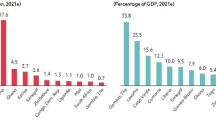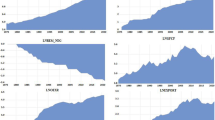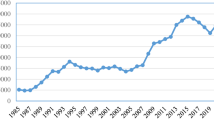Abstract
Although the relationship between remittances and output is still inconclusive in literature, most studies find that remittances have a positive effect on output in the long run. Contrary to this conventional direction of causality from remittances to output, our study finds that output alone determined long-run movements in remittances in a positive direction in the Bangladesh economy over the last 35 years from 1976 to 2010. We use the autoregressive distributive lag (ARDL) bounds testing approach to cointegration to explore this long-run relationship. Surprisingly, remittances do not appear to be a long-run forcing variable to the explanation of Bangladesh’s output over the same period. While examining the channels of this output–remittance mechanism remains an area of research for the future, we hypothesize that the rise in remittances in response to increased income occurs through higher import demand and greater investment opportunities. This finding implies that Bangladeshi policymakers can influence remittances through national output in the long run.

Similar content being viewed by others
References
Adams R, Page J (2005) Do international migration and remittances reduce poverty in developing countries? World Dev 33(10):1645–1669
Ahmed SA, Walmsley TL (2009) Gains from the liberalization of temporary migration: the case of India. South Asia Econ J 10(1):61–80
Ali SA (1981) An analysis of the institute of home remittance by Bangladeshi workers abroad on the national economy in labor migration from Bangladesh to Middle East. World Bank staff working paper 454, Washington, DC
Amusa H, Amusa K, Mabugu R (2009) Aggregate demand for electricity in South Africa: an analysis using the bounds testing approach to cointegration. Energy Policy 37:4167–4175
Ang AP (2007) Workers’ remittances and economic growth in the Philippines. http://www.ifw-kiel.de/VRCent/DEGIT/paper/degit_12/C012_029.pdf
Bahmani-Oskooee M, Oyolola M (2007) Export growth and output growth: an application of bounds testing approach. J Econ Finan 31(1):1–11
Banerjee A, Dolado J, Mestre R (1998) Error-correction mechanism tests for cointegration in single-equation framework. J Time Ser Anal 19:267–283
BBS (2010) Gross domestic product (GDP) of Bangladesh for 2004–2009. Bangladesh bureau of statistics. http://www.bbs.gov.bd/Home.aspx
BEA (2010) Data on GDP and GDP deflator. http://www.bea.gov/national/index.htm#gdp
Bentzen I, Engsted T (2001) A revival of the autoregressive distributed lag model in estimating energy demand relationships. Energy 26:45–55
BMET (2010) Overseas employment and remittances from 1976 to March, 2010. Bureau of manpower employment and training. http://www.hrexport-baira.org/flow_of_migration/flow_migration_dec.pdf
Brown RPC (1994) Migrants’ remittances, savings and investment in the South Pacific. Int Lab Rev 133(3):357–367
Catrinescua N, Leon-Ledesmab M, Pirachac M, Quillind B (2009) Remittances, institutions, and economic growth. World Dev 37(1):81–92
Chami R, Fullenkamp C, Jahjah S (2003) Are immigrant remittance flows a source of capital for development? IMF working paper 01/189. International monetary fund, Washington, DC
Chen SW (2008) Long-run aggregate import demand function in Taiwan: an ARDL bounds testing approach. Appl Econ Lett 15:731–735
Duasa J (2007) Determinants of Malaysian trade balance: an ARDL bounds testing approach. Glob Econ Rev 36(1):89–102
Faini R (2002) Development, trade, and migration. Proc ABCDE Eur Conf 1–2:85–116
Fosu OAE, Magnus J (2006) Bounds testing approach to cointegration: an examination of foreign direct investment, trade, and growth relationships. Am J Appl Sci 3(11):2079–2085
Frankel J (2009) Are bilateral remittances countercyclical? Center for international development at Harvard University. WP 185, http://www.hks.harvard.edu/centers/cid/publications/faculty-working-papers/cid-working-paper-no.-185
Ghatak S, Siddiki J (2001) The use of ARDL approach in estimating virtual exchange rates in India. J Appl Stat 28:573–583
Giuliano P, Ruiz-Arranz M (2009) Remittances, financial development, and growth. J Dev Econ 90:144–152
Glytsos N (2005) Dynamic effects of migrant remittances on growth: an econometric model with an application to Mediterranean countries. Lab and Demogr 0505014:1–38
GOB (2009–2011) National budgets, ministry of finance, government of Bangladesh. http://www.mof.gov.bd/en/budget/09_10/mtbf/en/Chapter_II.pdf, for 2009–2010, and http://www.mof.gov.bd/en/budget/10_11/budget_speech/10_11_en.pdf?phpMyAdmin = GqNisTr562C5oxdV%2CEruqlWwoM5, for 2010-2011
Hussain Z, Naeem F (2009) Remittances in Bangladesh: determinants and 2010 outlook. http://blogs. worldbank.org/endpovertyinsouthasia/print/514
IFAD (2010) Sending money home: Worldwide remittance flows to developing countries. International fund for agricultural development. http://www.ifad.org/remittances/maps/index.htm
IMF (2005) World economic outlook. International monetary fund, Washington, DC
Jalil A, Mahmud SF (2009) Environment kuznets curve for CO2 emissions: a cointegration analysis for China. Energy Policy 37:5167–5172
Johansen S, Juselius K (1990) Maximum likelihood estimation and inference on cointegration, with applications to the demand for money. Oxford Bull Econ Stat 52:169–210
Jongwanich J (2007) Workers’ remittances, economic growth, and poverty in developing Asia and the Pacific countries. UNESCAP working paper WP/07/01
Mahmud W (1989) The impact of overseas labour migration on the Bangladesh economy. In: Amajad R (ed) To the Gulf and back. International Labour Organisation (ILO), Geneva, p 55
Matin KA (1994) The overseas migrant workers, remittances and the economy of Bangladesh: 1976/77–1992/93. Dhaka Univ J Bus Stud 15(2):87–109
Morley B (2006) Causality between economic growth and immigration: an ARDL bounds testing approach. Econ Lett 90:72–76
Narayan PK (2004) Reformulating critical values for the bounds F statistics approach to cointegration: an application to the tourism demand model for Fiji. Department of economics discussion paper 02/04. Monash University, Melbourne
Narayan PK (2005) The saving and investment nexus for China: evidence from cointegration tests. Appl Econ 37(17):1979–1990
Odhiambo NM (2008) Energy consumption and economic growth nexus in Tanzania: an ARDL bounds testing approach. Energy Policy 37(2):617–622
Pahlavani M (2005) Analysing the trade-GDP nexus in Iran: a bounds testing approach. Economics working paper 131, University of Wollongon. http://ro.uow.edu.au/commwkpaapers/131, 1–14
Paul BP (2011) Modeling economic growth in Bangladesh and the role of the market economy. Int J Econ Issues 4(1) (forthcoming)
Pesaran MH, Pesaran B (1997) Working with Microfit 4.0: interactive econometric analysis. Oxford University Press, Oxford, pp 1–505
Pesaran MH, Shin Y (1999) An autoregressive distributed lag modelling approach to cointegration analysis. In: Strom S (ed) Chapter 11 in econometrics and economic theory in the 20th century: the ragnar frisch centennial symposium. Cambridge University Press, Cambridge, pp 371–413
Pesaran MH, Shin Y, Smith RJ (2001) Bounds testing approaches to the analysis of level relationships. J Appl Econ 16:289–326
Pradhan G, Upadhyay M, Upadhyaya K (2008) Remittances and economic growth in developing countries. Eur J Dev Res 20(3):497–506
Qayyum A, Javid M, Arif U (2008) Impact of remittances on economic growth and poverty: evidence from Pakistan, working paper. Pakistan Institute of Development Economics. http://mpra.ub.uni-muenchen.de/22941, 1–24
Rahman M (2009) Contributions of exports, FDI, and expatriates’ remittances to real GDP of Bangladesh, India, Pakistan and Sri Lanka. Southwest Econ Rev 36:141–153
Ratha D (2003) Workers’ remittances: an important and stable source of external development finance. Global Development Finance, World Bank, Washington, DC
Ratha D, Mohapatra S, Xu Z (2008) Outlook for remittance flows 2008–2010. Migration and development brief no. 8. Development prospects group, World Bank. http://siteresources.worldbank.org/INTPROSPECTS/Resources/334934-1110315015165/MD_Brief8.pdf
Salim RA (1992) Overseas remittances in Bangladesh: importance, potentialities and policy options. Jahangirnagar review, Part II, social science XIII and XIV. Jahangirnagar University, Dhaka
Stark O, Levhari D (1982) On migration and risk in LDCs. Econ Dev Cult Chang 31(1):191–196
Stark O, Lucas R (1988) Migration, remittances and the family. Econ Dev Cult Chang 36(3):465–481
Taylor JE (1992) Remittances and inequality reconsidered: direct, indirect and intertemporal effects. J Policy Model 14(2):187–208
Taylor JE (1999) The new economics of labor migration and the role of remittances in the migration process. Int Migr 37:63–89
Vita GD, Abbott A (2002) Are saving and investment cointegrated? An ARDL bounds testing approach. Econ Lett 77:293–299
WB (2009) World Development Indicators (WDI) data CD. World Bank, Washington, DC
Zarate-Hoys G (2004) Consumption and remittances in migrant households: toward a productive use of remittances. Contemp Econ Policy 22(4):555–565
Acknowledgments
The authors are thankful to the anonymous referees whose valuable comments on the previous versions substantially helped improve this study.
Author information
Authors and Affiliations
Corresponding author
Rights and permissions
About this article
Cite this article
Paul, B.P., Uddin, M.G.S. & Noman, A.M. Remittances and output in Bangladesh: an ARDL bounds testing approach to cointegration. Int Rev Econ 58, 229–242 (2011). https://doi.org/10.1007/s12232-011-0120-2
Published:
Issue Date:
DOI: https://doi.org/10.1007/s12232-011-0120-2




